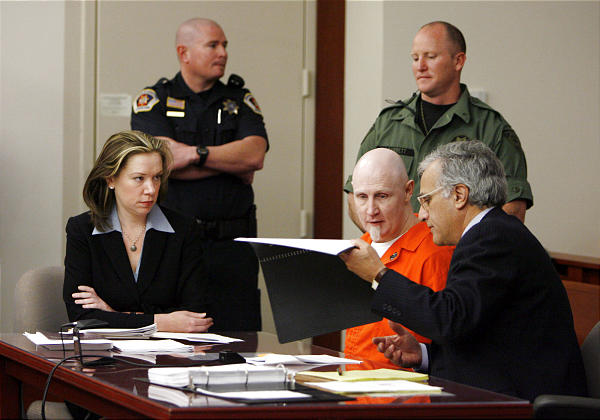
A state judge on Friday signed a warrant ordering that Ronnie Lee Gardner be put to death on June 18, setting the stage for Utah’s first execution in more than a decade.
The condemned man chose firing squad over lethal injection as the way he will die. Department of Corrections officials will choose the time of the execution, which will take place at the Utah State Prison in Draper.
Third District Judge Robin Reese signed the warrant, saying, “The defendant has exhausted all his legal remedies.”
“It’s my conclusion not to second-guess the courts or undertake an independent review,” he said.
Reese then said he assumed Gardner would want the method of execution he had chosen previously, to which Gardner, who appeared in court shackled and under heavy guard, said, “I would like the firing squad, please.”
Defense attorney Andrew Parnes said he would appeal to the Utah Supreme Court on Gardner’s behalf. Gardner could also ask the Board of Pardons and Parole to reduce his sentence to life in prison, a request that must be made by May 4.
The board can temporarily stop an execution to “fully hear” a commutation request, but attorneys for the state have said they believe there will be enough time for a hearing without a delay. At a hearing, witnesses testify for or against a life sentence. Neither side is allowed to cross-examine the other party’s witnesses, but the five board members can question them.
Gardner had filed a motion earlier in the week asking to participate in Friday’s hearing by phone, saying he has rheumatoid arthritis and suffers severe pain from being cuffed the entire time he is outside prison. But Reese ruled that the law required Gardner’s attendance.
Now 49, Gardner has spent more than half his life behind bars, including time as a juvenile. He is under a death sentence for the fatal shooting of attorney Michael Burdell during an April 2, 1985, escape attempt from a downtown Salt Lake City courthouse.
A 3rd District Court jury convicted Gardner of murder and he was given a death sentence in November 1985, which started years of appeals. Gardner periodically asked judges to allow him to die, either saying he was frustrated with delays in the case or racked with pain from rheumatoid arthritis, but then continued to challenge his sentence in both state and federal courts.
U.S. District Judge Tena Campbell in 2007 rejected all claims in an appeal by Gardner, including his assertion that his trial and appeal lawyers were ineffective because they failed to show he never meant to kill his victim. The judge said there was “overwhelming evidence” that Gardner intended to shoot Burdell.
Gardner appealed to the 10th U.S. Circuit Court of Appeals, which upheld Campbell’s decision last year. He asked for a review of the 10th Circuit ruling by the Supreme Court, which rejected his petition on March 8. The state Attorney General’s Office then asked for the death warrant.
Under state law and Administrative Code rules, the DOC officials will select five people, plus an alternate and a team leader, for a firing squad. All members must be certified peace officers.
Members of the news media will not have a view of the executioners, and the shooters’ identities will not be revealed.
The last inmate to die in Utah by firing squad was John Albert Taylor, who raped and murdered 11-year-old Charla King. On Jan. 26, 1996, he was hooded and strapped to a chair as five shooters took aim at a cloth target taped over his heart. Four executioners fired live rounds, while one weapon had a blank.
Taylor said he chose the firing squad over lethal injection to embarrass Utah, the only state with that option.
The last inmate executed in Utah was Joseph Mitchell Parsons, who was strapped on a gurney on Oct. 15, 1999, and pronounced dead about two minutes after being administered a lethal dose of drugs. Parsons was put to death for murdering Richard Lynn Ernest, a concrete laborer from Loma Linda, Calif., who had given him a ride.
Parsons was the sixth death-row inmate to be executed in Utah since the U.S. Supreme Court reinstated the death penalty in 1976.
The first in Utah and the nation to be put to death after reinstatement was Gary Gilmore on Jan. 17, 1977, for the murder of Bennie Bushnell, a motel manager in Provo. Gilmore chose the firing squad over hanging.
Utah’s death row has 10 inmates, including Gardner. All are men.